
Catalog excerpts
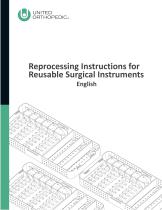
Reprocessing Instructions for Reusable Surgical Instruments English
Open the catalog to page 1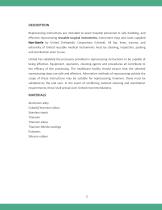
DESCRIPTION Reprocessing instructions are intended to assist hospital personnel in safe handling, and effective reprocessing reusable surgical instruments, instrument trays and cases supplied Non-Sterile by United Orthopedic Corporation (United). All hip, knee, trauma, and extremity of United reusable medical instruments must be cleaning, inspection, packing and sterilization prior to use. United has validated the processes provided in reprocessing instructions to be capable of being effective. Equipment, operators, cleaning agents and procedures all contribute to the efficacy of the...
Open the catalog to page 3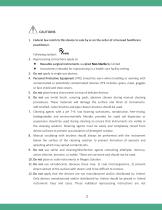
CAUTIONS 1. Federal law restricts this device to sale by or on the order of a licensed healthcare practitioner. Following symbol: 2. Reprocessing instructions apply to: Reusable surgical instruments supplied Non-Sterile by United Instruments intended for reprocessing in a health care facility setting Do not apply to single-use devices. Personal Protective Equipment (PPE) should be worn when handling or working with contaminated or potentially contaminated devices. PPE includes: gown, mask, goggles or face shield and shoe covers. Do not place heavy instruments on top of delicate devices....
Open the catalog to page 4
applicable that the devices are not manufactured and/or distributed by United. 13. Do not use descaling agents that include morpholine in steam sterilizers. These agents leave residue which may damage polymer instruments over time. 14. Do not stack cases or trays during sterilization. Because it may limit steam penetration and prevent effective sterilization of the instruments. 15. Under certain classifications of risk, the World Health Organization (WHO), or local regulatory authorities recommend special Creutzfeldt-Jakob disease (CJD/TSE) inactivation processing procedures. Consult WHO...
Open the catalog to page 5
CLEANING, INSPECTION, PACKAGING Remove contamination: As soon as possible after use, remove excessive soiling with a disposable wipe, rinse and flush lumened devices with sterile or deionized water to prevent the drying of soil and/or debris to the inside. Ensure that no instruments or pieces of instruments are left in the surgical site prior to closure, as they may not be detectable using imaging techniques such as X-ray or MRI and patient injury may result. Process instruments as soon as is reasonably possible after use. It is recommended not to delay cleaning for more than 2 hours. If...
Open the catalog to page 6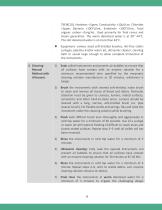
TIR34[10], Hardness <1ppm, Conductivity <10μS/cm, Chlorides <1ppm, Bacteria <10CFU/mL, Endotoxin <10CFU/mL, Total organic carbon <1mg/mL. Used primarily for final rinses and steam generation. The warm deionized water is at 30~ 44°C. The Hot deionized water is at more than 44°C. E. CleaningManual Method with Ultrasonic Equipment: various sized soft-bristled brushes, lint-free cloths syringes, pipettes and/or water jet, ultrasonic cleaner, cleaning bath or vessel large enough to allow complete immersion of the instruments. Soak soiled instruments and prevent air bubbles to ensure that all...
Open the catalog to page 7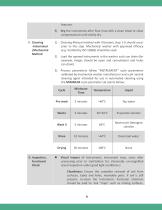
Cleaning-Manual method with Ultrasonic step 1-6 should occur prior to this step. Mechanical washer with approved efficacy (e.g. Verified by ISO 15883) should be used. Load the opened instruments in the washer such can drain (for example, hinges should be open and cannulations and holes can drain). F. Cleaning -Automated /Mechanical Method Dry the instruments after final rinse with a clean towel or clean compressed air until visibly dry. Process parameters follow "INSTRUMENT" cycle parameters validated by mechanical washer manufacturer and a pH neutral cleaning agent intended for use in...
Open the catalog to page 8
hinges, shafts of flexible reamers; recessed features (holes, cannulations) ; features where soil may be pressed into contact with the device, e.g. drill flutes adjacent to the cutting tip, sides of teeth on broaches and rasps. Note: If contamination is noted repeat the cleaning process. Completeness, damage and/or excessive wear: Visually inspect for no damage including but not limited to, malfunction, burrs, wear, tear, corrosion (rust, pitting), discoloration, creaked seals, excessive scratches and flaking. Note: If damage or wear is noted that may compromise the function of the...
Open the catalog to page 9
Smooth and free of cracks and Cracks and deep nicks. deep nicks. (Minor crack don’t affect the smooth operation is acceptable.) Loose burrs or large nicks. Hammering surfaces Flexible features Instrument tray/case Without burrs and large nicks. Flex and relax to inspect flexible feature like shafts, springs for any damage and major deformation Major deformation or can’t operate smoothly. Inspect for burrs and locking from damage the wrap. (Minor burr is acceptable.) Burrs or locking mechanism loosening which may damage the wrap. UDI Information Use DataMatrix barcode scanners to scan the...
Open the catalog to page 10
SterilContainer System -JN-400~JN-446 included with base vents use as packaging for the instrument sets. No more than one case can be placed directly into a rigid steam sterilization container. The total weight of a wrapped instrument case should not exceed 11.4kg/25lbs.
Open the catalog to page 11
STERILIZATION Using ANSI/AAMI ST79 Comprehensive Guide to Steam Sterilization and Sterility Assurance in Health Care is recommended to be steam sterilized by the health care facility using the process parameters below, which has been validated by United under laboratory conditions to provide a 10-6 sterility assurance level (SAL). A verified, properly maintained and calibrated steam sterilizer is recommended. The process parameters of sterilization should be followed explicitly. It is the responsibility of the medical facility to ensure that reprocessing is performed using the appropriate...
Open the catalog to page 12
STORAGE After sterilization, re-usable instruments should be stored the in the sterilization wrap in a dry and dust-free place. The shelf life is depending on the sterile barrier employed, storage manner, environmental conditions and handling. A maximum shelf life for sterilized re-usable instruments before use should be defined by each health care facility. VALIDATION INFORMATION For Manual Cleaning/Automated Cleaning Validation: The reusable devices are exposed to the artificial test soil which is a mixture of Edinburgh test soil and bone meal to simulate the clinical soil, and be dried...
Open the catalog to page 13All US Orthopedics catalogs and technical brochures
-
U2 Fixed Bearing Brochure
11 Pages







